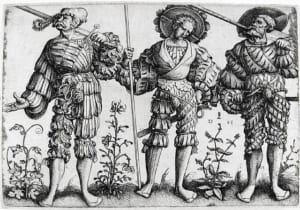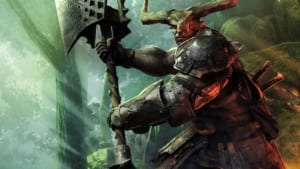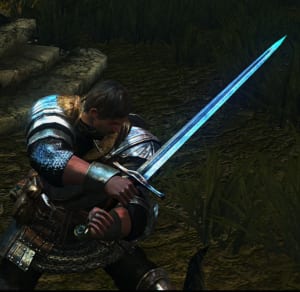Last time on the Fandomentals, I regaled you with my comments regarding crossbows in fantasy gaming. This time, I’d like to tackle another topic of historical weaponry in fantasy gaming. This time, however, I will discuss two-handed weapons of various sorts. It’s a martial style I am quite fond of, but one that games misrepresent with startling frequency.
First, let us address the elephant in the room. That is to say, the popular misconception, according to which, two-handed swords and similarly-sized weapons were heavy and unwieldy, thus requiring great strength and performing smashing blows. This is something I run into frequently, most recently on a Dragon Age blog. Now I have the opportunity to skewer (ha!) these myths more professionally than usual.
I’ll start by laying down some numbers. I’m going to support myself here with an essay, written by J. Clements from the Association for Renaissance Martial Arts.
The essay concerns greatswords, going with their definition as “a specialized and effective infantry weapon, and was recognized as such in the fifteenth and sixteenth centuries”, which it quotes from Swords and Hilt Weapons. It’s an interesting read in its own right, and helps us get acquainted with some basic facts. What interests me here is the table of physical characteristics of such weapons.

To pick a random example – a greatsword at 168 centimeters in length weighs 3.44 kilograms. Hardly the heavy, awkward monstrosity many games would have you picture it as. One that goes to a staggering 199 centimeters in length weighs 5.42 kilograms. And that’s for a piece that would be taller than most warriors who may wield it, and thus would most likely be ceremonial.
So, we established that real two-handed swords were a great deal lighter than we often picture them. Add to that the fact that they were wielded with both hands, which increases the control the user has over them. That, of course, only concerns two-handed swords. To round off my examples, I would like to use a brief characteristic of the bearded axe. As we can see, it weighs 3 pounds and 13 ounces, or around 1.72 kilograms, at the length of 42 inches, or 106 centimetres.
Such information doesn’t stop people from arguing that heavy, ponderous two-handed weapons are realistic. But it does show us that such an argument stems from ignorance.
Having said that, there is an argument for keeping them heavy that’s actually valid. Namely, that of game balance. In some games, computer and tabletop alike, two-handed weapons need to coexist with weapon styles that occurred in entirely different circumstances in history – such as rapier fencing and other more “civilian” methods. In such a case, emphasizing their weight beyond what’s realistic can be a way to make sure they don’t get the same advantage they would have in the real world.
Now that we have some groundwork, I’ll go over some examples of how my favorite weapon type appears in games. Let’s start with my personal worst offender – the Dragon Age series. The first installment, Dragon Age: Origins, has them swing like cricket bats made out of lead – literally, since the motion is very resembling of a club or bat used for sport. This is somewhat less noticeable due to the fact that Origins’ combat is dreadfully slow and lacking in any sort of martial grace in any event.
Dragon Age 2 changes it considerably. Combat in that game is significantly more cinematic and flashy, with faster moves. I won’t say “less realistic”, because Origins’ combat has precious little to do with realism, despite gratuitous splashes of blood (that somehow ends up on the characters’ backs) and significant quantities of the color brown. But it is unrealistic in the completely opposite direction, as it were.
The decision was controversial. Much of the controversy had its source in glaring misconceptions about what “realistic combat” entails, but Dragon Age 2 did push the pendulum in the opposite direction hard enough that it’s perfectly reasonable to find it displeasing.
The third game of the series, Dragon Age: Inquisition, scales back on the flashiness without going back to looking like a team of malnourished re-enactors with stone weapons… well, except for two-handed weapons. Their motions are worse than in Origins. It’s bad enough when you perform regular attacks with it, but when you use one of the special abilities… you leave a crack in the ground. The prosecution rests.

The motivation behind it was apparently to give some “real weight” to these weapons, according to one of the creators. God in heaven. I don’t find people swinging weapons like they’re traffic signs terribly impressive, but maybe I’m odd. Needless to say, it was widely lauded as “bringing back the realism”. That’s why I don’t have high hopes for the fourth game on this front.
I mentioned game balance earlier, but Dragon Age doesn’t really get this excuse. The only weapon choices available to warriors are weapon and shield, two weapons or a two-handed weapon. The option to wield a weapon in each hand disappears after Origins. And there’s no reason to handicap two-handed weapons if the only other option is a shield, which brings with it an entirely different combat technique.
Well, moving on. The next video game on the docket for this is Dark Souls. My beloved swearword-eliciting series of games is a curious case in this regard. By and large, weapons classified as “greatswords”, “greataxes” and the like are bulky. The second and third game introduce some weapons in the “greatsword” category that have elegant move-sets, actually resembling real-life longsword fencing somewhat.
But the tricky part is that every weapon in the game can be used with one or two hands. Even daggers, which looks  about as ridiculous as you’d expect. Still, you can hold a nominally one-handed weapon in two hands, which increases the damage you receive from the strength attribute. It actually works quite well – I beat the entire first game by using the humble beginner longsword this way.
about as ridiculous as you’d expect. Still, you can hold a nominally one-handed weapon in two hands, which increases the damage you receive from the strength attribute. It actually works quite well – I beat the entire first game by using the humble beginner longsword this way.
It’s hard for me to judge the designers’ intentions, but it would appear likely that the game balance issue played a part. If all two-handed weapons had fast move-sets, there would be less reason to use smaller weapons in only one hand. I can accept that. It becomes a bit more complicated with the introduction of “light” greatswords, though.
A honorary mention has to go to Guild Wars 2, where greatswords are quick and fluid weapons for all classes that use them. The movements are rather over exaggerated, but at least they’re not slow. If only it weren’t so hard to find greatswords that don’t look like sharpened surfboards… The other two-handed options for close combat are hammers and (in case of some classes) staves. Perhaps even more surprisingly, two-handed hammers’ animations don’t look like a broken spine waiting to happen either. Of course, they don’t look like anything you could actually use as a weapon, but that’s just part and parcel of the concept.
Tabletop role-playing games are a different topic here. Combat is narrated by players and game-masters, so any weapon’s aesthetic is dictated by a group’s personal approach. That’s not to say a game can’t reinforce or downplay certain imagery.
In my experience, the problem I’m describing doesn’t exist in tabletop games as much as it does in video games. Even Dungeons & Dragons, whose depiction of martial combat is notoriously horrendous, doesn’t serve us depictions of two-handed weapons as extremely heavy. When it bothers to give unique abilities to different types of weapons, it tends to emphasize powerful blows in case of two-handers, but it’s not to the same degree as Dragon Age’s lead replicas.
Nonetheless, the omission of the elegance and style inherent in using two-handed weapons has long been my personal windmill to tilt at. Just look at the video below to see what it can look like:
Now, in fairness – those aren’t the swords described in the article I linked to above. They’re what you would call longswords, rather than greatswords. Two-handed weapons in games gravitate towards the immense greatswords of 16th century and beyond, as John Clements puts it in another article – inasmuch as they have any connection to reality. Lighter two-handed weapons, referred to sometimes as hand and half weapons, have an ambiguous position in gaming.
As far as tabletop games, the only one I can think of that acknowledges this particular fighting style is Song of Swords, a spiritual successor to Riddle of Steel. Dungeons and Dragons makes some nods towards two-handed weapons that aren’t massive tools of carnage now and then, but they tend not to be worth the effort.
In terms of video games, two of them are very good examples here. First is Dark Souls, which I mentioned above. It allows the player to wield a straight sword in two hands, which is an entirely valid style of play. The second and third game also include greatsword-class weapons with less heavy move sets.
The crowning example of this style’s existence are the Witcher games, however. A witcher’s two signature swords are very much examples of longswords, and while combat in those games is still not realistic by any stretch, it’s nonetheless closer to longsword fencing. Of course, Witcher restricts itself to swords. Using hand-and-half axes isn’t an option.

The omission of this fighting style is a little odd, to be frank. After all, it’s iconic. You need only look at Lord of the Rings to find Aragorn. Andúril is hardly a greatsword, and its construction in the films is very similar to longsword and their modern replicas. He’s hardly alone among fantasy heroes in its use. To keep with the LotR example, Gimil’s axe is hardly the monstrosity two-handed axes tend to appear as, either.
I really think it’s a shame, because it offers a whole new design space. This way, we can actually have our cake and eat it too, by letting huge axes and massive greatswords do their thing, while giving light-weight two-handed weapons their own niche. But RPGs, both tabletop based and computer based, are very resistant to innovation. So I’ll remain dreaming and hoping.
I hope you enjoyed my skewering of some common misconceptions, and bringing up some examples of two-handed weapons in gaming. Tune in next time, when I’ll take apart more fixtures of video and tabletop gaming.

